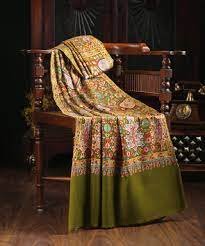GI (Geographic Indication) labels have been issued by the Jammu and Kashmir administration to nearly 20,000 Pashmina shawls and 9,000 carpets, marking a significant accomplishment. In an effort to combat counter-branding, GI tags were added to Kashmir’s carpet and Pashmina shawls in the years 2021 and 2022.
The government of Jammu and Kashmir has announced a major development for the handicraft sector in the area after article 370. In accordance with the 2020 introduction of the Handicraft and Handloom Policy, seven Kashmiri handicraft products now carry Geographical Indication badges.
Kashmiri crafts have been rejuvenated by this twofold strategy, which has helped them gain recognition on a national and international level. artisans who are deeply rooted in these customs will benefit tremendously from the Handicraft and Handloom Policy 2020 and the Geographic Indication Tags.

According to data provided to news agency KNO, 20,126 Pashmina Shawls have received GI labels as of October. In the same period, 9,700 carpets have also received the tag labels.
What is GI?
A product can be identified with GI – Geographic Indication, tagging if it comes from a particular geographic origin and has attributes, reputation, or features that are primarily related to that origin.
This acknowledgment not only increases the worth of the products but also safeguards traditional production techniques and guarantees that customers are receiving genuine, high-quality products.
According to the official document, tagging has increased the handicrafts of Jammu and Kashmir’s visibility and protection, which has boosted the region’s economy. “Jammu and Kashmir is now the first Union Territory/State in India to identify all of its crafts with QR codes. This action is expected to help strengthen the local economy and provide these crafts more respect and protection,” the statement read.
According to the paper, 12 other crafts—seven from Kashmir and five from Jammu—are in the works to be tagged as Geographic Indication.
The government of Jammu and Kashmir has been implementing several measures to safeguard and encourage the handicrafts that are part of the region’s rich legacy. Ten crafts from Jammu and Kashmir have already been recognized under the Geographical Indication tag as part of this initiative. These crafts include Basholi painting, Basholi Pashmina, Carpet, Sozni, Kashmir Papier Mache, Kani Shawl, Khatamband, and Chikri wood.
The Export Strategy
According to data, handicrafts worth Rs 4,740 crore have been exported to different countries over the last four years. Official data states that handicrafts were exported for Rs 1116.37 crore in FY 2022–23 as opposed to Rs 563.13 crore in FY 2021–22.
Jammu and Kashmir is reported to have exported handicrafts worth Rs 208.21 crore to the rest of the world in the first quarter of this year.
It also claims the administration is developing an export plan to double exports over the next five years. “With the goal of doubling exports in five years, export strategies for pashmina, carpets, paper machie, walnut, and sozni are being prepared.” An agreement was signed with NIFT on modern packaging and design.
Seven iconic Kashmiri crafts—Pashmina, Kashmir Sozni, Kani Shawl, Papier-mâché, Kashmiri Crafts, Khatamband, and walnut wood carving have been officially granted Geographical Indication Tags, confirming their origin in the Kashmir region, according to Mahmood Ahmad Shah, Director of Handicrafts and Handloom Kashmir.
“Our department started the Pashmina Geographic Indication tags a few years ago. 9,800 labels for carpets and 20,000 labels for Pashmina had been provided, according to Shah’s statement.
In terms of non-GI crafts including crewel, copper crafts, Namdah, Gamba, and chain stitch, QR Code-based labels will be implemented. With the use of this strategy, buyers should be able to tell handmade products from machine-produced products with ease while making purchases. It is expected that the implementation of GI Tags and QR-based labeling will increase consumer trust in the authenticity of Kashmiri handicrafts in both domestic and foreign markets.
Shah continued, “The GI Tags and QR code-based labels on handicraft products will not only encourage the consumption of local products but also translate into substantial economic advantages for artisans and weaving communities in Jammu and Kashmir.”
GI Surge in Global Market
Craft exports to foreign markets have increased by a remarkable 98% in the last year. The increase in sales of exported goods can be attributed to the increasing credibility that Kashmiri crafts have gained in the global arena.
This innovative approach offers a variety of programs designed to improve the well-being of artisans in Jammu & Kashmir. Programs include Education Support for Children of Artisans, the Artisans Credit Card, the Karkhandar Scheme, Financial Assistance for Cooperative Societies, and a noteworthy 10 percent incentive for export goods recognized by GI.
The last three years have seen a surge in both domestic and foreign travel to the area, which has increased the significance of craft tourism in the Kashmir valley. This spike in tourism has been very beneficial to the artists who create a wide variety of handicrafts, improving their chances of making a living.

Handicrafters from Kashmir have garnered significant attention, having won six National prizes in different craft categories and two Shilp Guru honors in the year 2022.
This year, Prime Minister Narendra Modi inaugurated the building, showcasing the talent and commitment of the talented artisans.
Marking a historic accomplishment, the new parliament building on Rajpath was adorned with artwork created by 48 craftsmen from the Khag tehsil, with 12 Silk Kashmiri handwoven carpets put together by artisans in the central Kashmiri Budgam district.












Comments 2